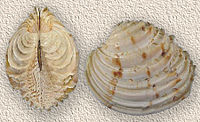
Photo from wikipedia
Abstract Striped venus clam, Chamelea gallina, is an economically important clam species inhabiting coastal waters of the Mediterranean Sea, the Adriatic Sea, the Black Sea, and the Eastern Atlantic Ocean… Click to show full abstract
Abstract Striped venus clam, Chamelea gallina, is an economically important clam species inhabiting coastal waters of the Mediterranean Sea, the Adriatic Sea, the Black Sea, and the Eastern Atlantic Ocean coasts of Europe. Despite the economic value of the species, there is limited information about genetic variability and structure on a geographical scale. In this study, the population genetic structure of C. gallina sampled from the Black Sea, the Levantine Sea, the Adriatic Sea, and the Atlantic Ocean was assessed by using microsatellites, mtDNA and nuclear markers. No significant genetic difference was found between sampling sites and geographic regions based on the microsatellite analysis leading to the inference that gene flow was sufficient across sampling sites. Positive and significant spatial autocorrelation of microsatellite genotypes was detected among C. gallina sampled within the geographic range of 100−300 km. The structure analysis did not reveal population sub-structuring. High level of genetic homogeneity in the Black Sea indicates that striped venus clam could be managed at the regional level. COI appeared to be comparatively more polymorphic than 16S rRNA and ITS2. Based on COI and 16S rRNA sequence analysis, the Black Sea specimens were identified and separated from the Levantine Sea, the Adriatic Sea, and the Atlantic Ocean specimens. Both mtDNA and nuclear markers were able to discriminate C. gallina and C. striatula. Meanwhile, microsatellite loci were successfully cross amplified in C. striatula specimens but did not discriminate taxa. Our study revealed the extant population genetic structure of C. gallina and explained the weak population structure of a species with a long planktonic larval stage.
Journal Title: Fisheries Research
Year Published: 2021
Link to full text (if available)
Share on Social Media: Sign Up to like & get
recommendations!